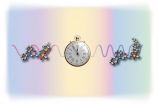(Press-News.org) Two young researchers working at the MIPT Laboratory of Nanooptics and Plasmonics, Dmitry Fedyanin and Yury Stebunov, have developed an ultracompact highly sensitive nanomechanical sensor for analyzing the chemical composition of substances and detecting biological objects, such as viral disease markers, which appear when the immune system responds to incurable or hard-to-cure diseases, including HIV, hepatitis, herpes, and many others. The sensor will enable doctors to identify tumor markers, whose presence in the body signals the emergence and growth of cancerous tumors.
The sensitivity of the new device is best characterized by one key feature: according to its developers, the sensor can track changes of just a few kilodaltons in the mass of a cantilever in real time. One Dalton is roughly the mass of a proton or neutron, and several thousand Daltons are the mass of individual proteins and DNA molecules. So the new optical sensor will allow for diagnosing diseases long before they can be detected by any other method, which will pave the way for a new-generation of diagnostics.
The device, described in an article published in the journal Scientific Reports, is an optical or, more precisely, optomechanical chip. "We've been following the progress made in the development of micro- and nanomechanical biosensors for quite a while now and can say that no one has been able to introduce a simple and scalable technology for parallel monitoring that would be ready to use outside a laboratory. So our goal was not only to achieve the high sensitivity of the sensor and make it compact, but also make it scalabile and compatibile with standard microelectronics technologies," the researchers said.
Unlike similar devices, the new sensor has no complex junctions and can be produced through a standard CMOS process technology used in microelectronics. The sensor doesn't have a single circuit, and its design is very simple. It consists of two parts: a photonic (or plasmonic) nanowave guide to control the optical signal, and a cantilever hanging over the waveguide.
A cantilever, or beam, is a long and thin strip of microscopic dimensions (5 micrometers long, 1 micrometer wide and 90 nanometers thick), connected tightly to a chip. To get an idea how it works, imagine you press one end of a ruler tightly to the edge of a table and allow the other end to hang freely in the air. If you touch the latter with your other hand and then take your hand away, the ruler will start making mechanical oscillations at a certain frequency. That's how the cantilever works. The difference between the oscillations of the ruler and the cantilever is only the frequency, which depends on the materials and geometry: while the ruler oscillates at several tens of hertz, the frequency of the cantilever's oscillations is measured in megahertz. In other words, it makes a few million oscillations per second!
There are two optical signals going through the waveguide during oscillations: the first one sets the cantilever in motion, and the second one allows for reading the signal containing information about the movement. The inhomogeneous electromagnetic field of the control signal's optical mode transmits a dipole moment to the cantilever, impacting the dipole at the same time so that the cantilever starts to oscillate.
The sinusoidally modulated control signal makes the cantilever oscillate at an amplitude of up to 20 nanometers. The oscillations determine the parameters of the second signal, the output power of which depends on the cantilever's position.
The highly localized optical modes of nanowave guides, which create a strong electric field intensity gradient, are key to inducing cantilever oscillations. Because the changes of the electromagnetic field in such systems are measured in tens of nanometers, researchers use the term "nanophotonics" - so the prefix "nano" is not used here just as a fad! Without the nanoscale waveguide and the cantilever, the chip simply wouldn't work. Abig cantilever cannot be made to oscillate by freely propagating light, and the effects of chemical changes to its surface on the oscillation frequency would be less noticeable..
Cantilever oscillations make it possible to determine the chemical composition of the environment in which the chip is placed. That's because the frequency of mechanical vibrations depends not only on the materials' dimensions and properties, but also on the mass of the oscillatory system, which changes during a chemical reaction between the cantilever and the environment. By placing different reagents on the cantilever, researchers make it react with specific substances or even biological objects. If you place antibodies to certain viruses on the cantilever, it'll capture the viral particles in the analyzed environment. Oscillations will occur at a lower or higher amplitude depending on the virus or the layer of chemically reactive substances on the cantilever, and the electromagnetic wave passing through the waveguide will be dispersed by the cantilever differently, which can be seen in the changes of the intensity of the readout signal.
Calculations done by the researchers showed that the new sensor will combine high sensitivity with a comparative ease of production and miniature dimensions, allowing it to be used in all portable devices, such as smartphones, wearable electronics, etc. One chip, several millimeters in size, will be able to accommodate several thousand such sensors, configured to detect different particles or molecules. The price, thanks to the simplicity of the design, will most likely depend on the number of sensors, being much more affordable than its competitors.
INFORMATION:
This work was financed by the Russian Ministry of Education and Science through state order # 16.19.2014 / K.
Two years ago, the Immunology of Diabetes Research Group at the Germans Trias Research Institute (at Universitat Autònoma de Barcelona - Campus of International Excellence Sphere) reported a new experimental immunotherapy that prevented the onset of Type 1 Diabetes in mice predisposed to the disease. This work led to more studies with the support of the Spanish Government, Catalan Government and private patrons with a keen interest in it. Thanks to this, the article published today in PLOS ONE describes a new step towards the creation of a vaccine, which in the medium-term ...
June 9, 2015 - New approaches, based on body mass index (BMI) or other simple measures, are needed to improve assessment of obesity in adolescents with physical disabilities, reports a paper in the American Journal of Physical Medicine & Rehabilitation, the official journal of the Association of Academic Physiatrists. The journal is published by Wolters Kluwer.
Obesity is a major problem in children and adolescents with mobility limitations, but standard assessments tend to underestimate it, according to the new research by Brooks C. Wingo, PhD, of University of Alabama ...
Nagoya, Japan - A team of chemists and biologists at the Institute of Transformative Bio-Molecules (ITbM), Nagoya University have succeeded in finding new molecules that change the circadian rhythm in mammals by applying synthetic chemistry methods, which makes use of highly selective metal catalysts.
Most living organisms have a biological clock with an approximately 24-hour circadian rhythm, which regulates important body functions such as sleep/wake cycles, hormone secretion, and metabolism. Disruption of the circadian rhythm by genetic mutations and environmental ...
LOS ANGELES (JUNE 8, 2015) - The witness on the stand says he saw the accused at the scene of the crime. Is he sure? How sure? The jury's verdict could hinge on that level of certainty.
Many decisions we make every day are influenced by our memories and the confidence we have in them. But very little is known about how we decide whether we can trust a memory or not.
A new Cedars-Sinai study provides some of the answers. Researchers have identified a unique set of neurons in the medial temporal lobe, an area of the brain where memories and memory-based decisions are ...
The use of camera traps -- remote automatic cameras triggered by heat or motion -- has revolutionized wildlife ecology and conservation research. But the large number of images generated through the traps creates the problem of categorizing and analyzing all the images.
For a recent project conducted in the Serengeti National Park, Alexandra Swanson, turned to another relatively new technology -- a citizen science platform. The Snapshot Serengeti project asked non-scientist volunteers to review 1.2 million sets of images. A description of the project, 'Snapshot Serengeti, ...
A variety of factors including questions about risk and reluctance to offend patients limits clinician willingness to prescribe a potentially life-saving medication that counteracts the effects of an opioid overdose, according to a Kaiser Permanente Colorado study published today in the Journal of General Internal Medicine.
The number of fatal overdoses from opioid medications has quadrupled in the U.S. since 1999. According to the Centers for Disease Control and Prevention (CDC), each day 44 people die of prescription painkiller overdoses. In the event of an overdose, ...
American physicians with waivers allowing them to provide office-based medication-assisted buprenorphine treatment to patients addicted to opioids were able to increase potential access to effective medication-assisted treatment by 74 percent from 2002 to 2011, according to a new RAND Corporation study.
Published in the June issue of the journal Health Affairs, the study shows that the increased number and geographic distribution of physicians obtaining waivers to prescribe buprenorphine has widened potential access to effective treatment for those with addiction to heroin ...
Getting through the pollen season can now become easier for some of the approximately 500 million people worldwide who suffer from sneezing and a runny nose, watery eyes and drowsiness during the allergy season (seasonal allergic rhinitis).
This is indicated by a controlled trial carried out by researchers from Aarhus University. The trial, which took place over two days, included 65 people with grass pollen allergies who were not receiving any medical treatment at that time. They were either equipped with a nasal filter or a placebo device.
The conclusion was that the ...
Chicago, June 9, 2015 - A more aggressive approach to treating degenerative mitral valve disease, using earlier surgical intervention and less invasive techniques, is more beneficial to the patient than "watchful waiting," according to an article in the June 2015 issue of The Annals of Thoracic Surgery.
Key points
Earlier surgical intervention using less invasive surgical techniques is better than watchful waiting for patients with degenerative mitral valve disease.
Over the 25 years observed, mortality rates remained low, hospital length of stay was shorter, ...
Athens, Ga. - Researchers in the University of Georgia's Regenerative Bioscience Center are visually capturing the first process of chromosome alignment and separation at the beginning of mouse development. The findings could lead to answers to questions concerning the mechanisms leading to birth defects and chromosome instability in cancer cells.
"We've generated a model that is unique in the world," said Rabindranath De La Fuente, an associate professor in the UGA College of Veterinary Medicine. "Because we removed ATRX protein expression only in the oocyte, the female ...



